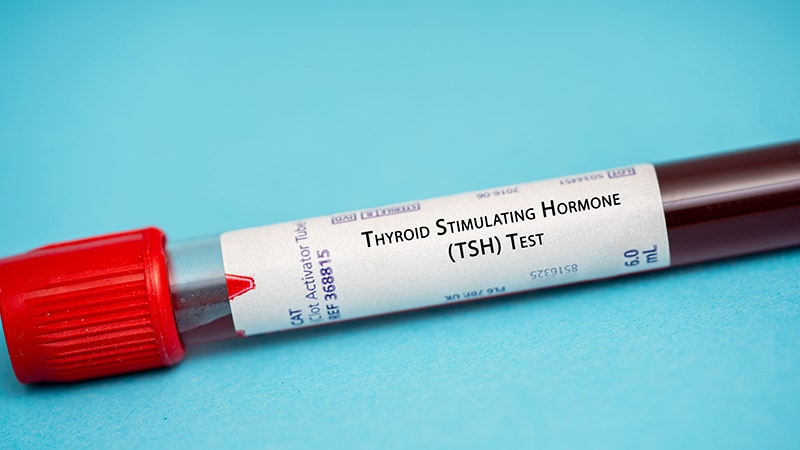Seasonal variation in one of the hormones used to monitor thyroid function could in turn lead to false diagnoses of subclinical hypothyroidism and unnecessary prescriptions of levothyroxine, says Yale clinical chemist Joe M. El-Khoury, PhD.
He says a Japanese study in more than 7000 healthy individuals showed that thyrotropin-stimulating hormone (TSH) varies widely throughout the seasons, peaking in the northern hemisphere’s winter months (January to February) with its low in the summer months (June to August); that paper was published last year in the Journal of the Endocrine Society.
But free thyroxine (FT4) levels in the Japanese population remained relatively stable, he writes in a letter recently published in Clinical Chemistry.
“If you end up with a mildly elevated TSH result and a normal FT4, try getting retested 2-3 months later to make sure this is not a seasonal artifact or transient increase before prescribing/taking levothyroxine unnecessarily,” advises El-Khoury, who is director of Yale University’s Clinical Chemistry Laboratory, New Haven, Connecticut.
“Because the [population-based, laboratory] reference ranges don’t account for seasonal variation, we’re flagging a significant number of people as high TSH when they’re normal, and physicians are prescribing levothyroxine inappropriately to healthy people who don’t need it,” he told Medscape Medical News, adding that overtreatment can be harmful, particularly for elderly people.
This seasonal variation in TSH could account for between a third to a half of the 90% of all levothyroxine prescriptions that were found to be unnecessary, according to a US study in 2021, El-Khoury adds.
Asked to comment, Trisha Cubb, MD, told Medscape Medical News that El-Khoury’s letter “raises a good point, that we really need to look at our reference ranges, especially when more and more studies are showing that so many thyroid hormone prescriptions may not be necessary.”
Cubb, who is thyroid section director and assistant professor of clinical medicine at Weill Cornell Medical College/Houston Methodist Academic Institute, Texas, also agrees with El-Khoury’s suggestion to repeat lab results in some instances.
“I think repeating results, especially in our patients with subclinical disease, is important,” she noted.
And she pointed out that seasonal variation isn’t the only relevant variable. “We also know that multiple clinical factors like pregnancy status, co-existing comorbidities, or age can all influence what we as clinicians consider an acceptable TSH range in an individual patient.” And other medications, such as steroids, or supplements like biotin, “can all affect thyroid lab values,” she noted.
“Ensuring that minor abnormalities aren’t transient is important prior to initiating medical therapy. With any medical therapy there are possible side effects, along with time, cost, [and] monitoring, all of which can be associated with thyroid hormone replacement.”
TSH Reference Ranges Should Be Adapted for Subpopulations
El-Khoury explained that to get an idea of how big the seasonal differences in TSH observed in the Japanese study were, “the upper end of the population they tracked goes from 5.2 [mIU/L] in January to 3.4 [mIU/L] in August. So you have almost a 2-unit change in concentration that can happen in the reference population. But laboratory reference ranges, or ‘normal ranges,’ are usually fixed and don’t change by season.”
The higher the TSH, the more likely a person is to have hypothyroidism. Major recent studies have found no benefit of levothyroxine treatment with TSH levels below 7.0-10.0 mIU/L, he said.
“So, I suggest that the limit should be 7.0 [mIU/L] to be safe, but it could be as high as 10 [mIU/L]. In any case, let’s shift the mindset to clinical outcome–based treatment cutoffs,” he said, noting that this approach is currently used for decisions on cholesterol-lowering therapy or vitamin D supplementation, for example.
Regarding this suggestion of using a TSH cutoff of 7 mIU/L to diagnose subclinical hypothyroidism, Cubb said: “It really depends on the specific population. In an elderly patient, a higher TSH may be of less clinical concern when compared to a female who is actively trying to get pregnant.”
“Overall, I think we do need to better understand what appropriate TSH ranges are in specific subpopulations, and then with time, make this more understandable and available for general medicine as well as subspecialty providers to be able to utilize,” she noted.
Regarding the particular Japanese findings cited by El-Khoury, Cubb observed that this was a very specific study population, “so we would need more data showing that this is more generalizable.”
And she noted that there’s also diurnal variation in TSH. “In the [Japanese] paper, patients had their thyroid labs drawn between 8:00 AM and 9:00 AM in a fasting state. Oftentimes in the US, thyroid labs are not drawn at specific times or [during] fasting. I think this is one of many factors that should be considered.”
Acknowledging Seasonal Variation Would Be a Start
But overall, Cubb said that both the Japanese study and El-Khoury’s letter highlight “how season, in and of itself, which is not something we usually think about, can affect thyroid lab results. I believe as more data come out, more generalizable data, that’s how evidence-based guidelines are generated over time.”
According to El-Khoury, fixing the laboratory reference range issues would likely require a joint effort of professional medical societies, reference laboratories, and assay manufacturers. But with seasonal variation, that might be a difficult task.
“The problem is, in laboratory medicine, we don’t have rules for an analyte that changes by season to do anything different. My goal is to get people to at least acknowledge this is a problem and do something,” he concluded.
El-Khoury and Cubb have reported no relevant financial relationships.
Clin Chem. Published online March 1, 2023. Abstract
Miriam E. Tucker is a freelance journalist based in the Washington, DC, area. She is a regular contributor to Medscape, with other work appearing in The Washington Post, NPR’s Shots blog, and Diabetes Forecast magazine. She is on Twitter: @MiriamETucker.
For more diabetes and endocrinology news, follow us on Twitter and Facebook.
Source: Read Full Article






